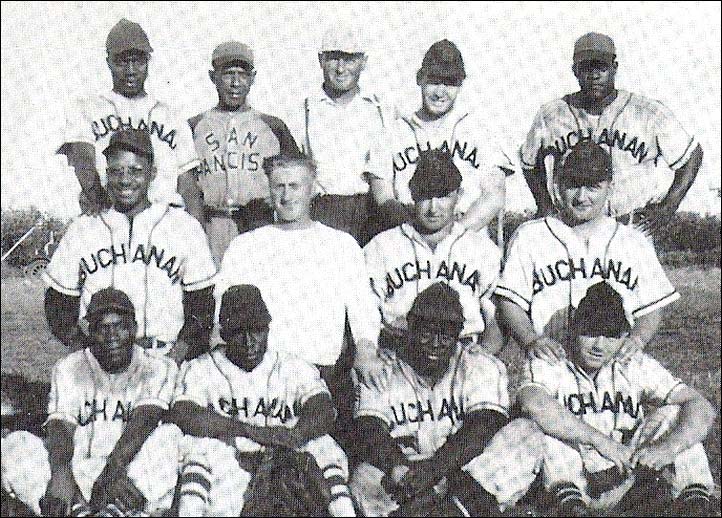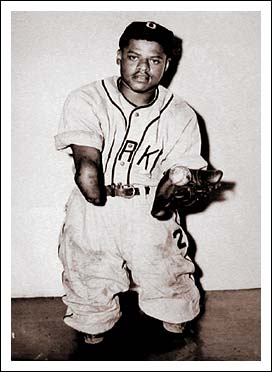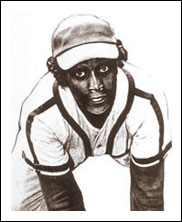
The San Francisco Sea Lions, a barnstorming team from California, ran into financial problems during a 1949 tour of Western Canada. Seven of the players jumped the team to bolster the local Buchanan (Saskatchewan) ball squad.
Back row (left to right) Junior Walton, Papy Dyk, Mike Lukey (coach), John Johanson, Lee Landrum. Centre row Mule Jones, Edgar Myrfield (sponsor), John Wishlow, John Plaxin. Front row John Henry, Chizun, Lefty Jackson, Lorne Johanson.
Below - Sammy Workman, a main attraction of the Sea Lions' tour. Without feet or hands, Workman would put on a demonstration of hitting, running and throwing during each game. Lee Landrum is the catcher in the photo below. If you look closely you'll note he put running shows on backwards to help with balance. (Photos courtesy of Lorne Plaxin)

[The two Sammy Workman photos below from the Oakland Museum of California, Catalog ID:
H99.29.40 & ID: H99.29.39]



Left - Toni Stone (described in the ads for the SF Seals as "Sensational Girl Player") broke the gender line in the Negro Leagues. She toured with the Sea Lions in 1949 (but, apparently not on the Canadian swing) and also played with the New Orleans Black Pelicans and New Orleans Creoles.
Stone (her real name was Marcenia Lyle Alberga) played Negro League ball with the Indianapolis Clowns in 1953 and Kansas City Monarchs in 1954. She retired at the end of the 1954 season.
Photo courtesy National Baseball Hall of Fame.
Sammy Workman, a leading draw for the Sea Lions in 1949 (and the Oakland Larks in 1946 and 1947). Workman, without hands or feet, would exhibit his talents at batting, catching and pitching a ball.
" ... To say nothing of Sammy Workman, whom Harris [Eddie Harris of the Oakland Larks] says has proved an inspiration to disabled veterans everywhere the Larks have appeared ... When Workman was two years old he contracted a rare disease that required the amputation of is arms and legs to save his life ... Undiscouraged by this tremendous handicap, Workman as he grew older, made himself into an athlete and a ball player. Workman can throw a baseball a hundred feet with speed and accuracy and can scamper around the bases in fine style ... "He's been an inspiration to hundreds of crippled servicemen," said Harris ... "He can do anything a normal man can do, including dressing himself ... And he's an accomplished jitterbug." (Oakland Tribune, July 23, 1947)
" ... Sammy, whose arms are off just below the elbows and whose legs were amputated at the knees, was even better than his advance notices claimed. His skit included a session as catcher in which he flipped the ball back to the pitcher, and an appearance at the plate enlivened by an "argument" with the umpire. Disgusted after two called strikes, Sammy then whacked a high fly into the crowd which had swarmed in just behind third base for a better view. And, like the book says, Sammy can run, too. He slide into second while the crowd roared." (The Charleston Daily Mail, July 11, 1948)
Life Magazine was reported to have published a feature on Workman in early 1949.
The Sea Lions were a part of an attempt to bring major Negro League ball to the West Coast. The league folded mid-way through the first season, but the Sea Lions continued play, with barnstorming a big part of the action. In 1958, the Sea Lions were invited to tour the Philippines where they won 19 of 23 games.
During the Canadian swing of their 1949 tour the owner of the Sea Lions, Harold "Yellowhorse" Morris, admitted (on June 29, 1949) he had lost his ball players to the Buchanan All-Stars. The Sea Lions were scheduled to play Regina Caps in a double-header, but the All-Stars played instead. The only team member left for Morris was Sammy Workman.
